380th Expeditionary Operations Group
| 380th Expeditionary Operations Group | |
|---|---|
|
Emblem of the 380th Expeditionary Operations Group | |
| Active | 1942–1946; 1947–1951; 2002–present |
| Country | United States |
| Branch | United States Air Force |

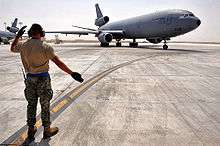

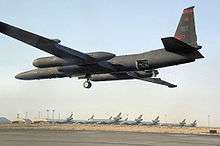
The 380th Expeditionary Operations Group (380 EOG) is the operational flying component of the United States Air Force 380th Air Expeditionary Wing. It is a provisional unit stationed at Al Dhafra Air Base, United Arab Emirates, and is assigned to the United States Air Forces Central component of Air Combat Command (ACC).
The unit's World War II predecessor unit, the 380th Bombardment Group, operated primarily in the Southwest Pacific Theater as a B-24 Liberator heavy bombardment unit assigned to Fifth Air Force. In addition to flying combat missions, the group operated as a training unit for Royal Australian Air Force crews in B-24 operations. It was awarded both the United States Distinguished Unit Citation and the Philippine Presidential Unit Citation for its combat service in Borneo, New Guinea and the Philippines.
Reactivated in 2002, the 380 EOG conducts combat operations as part of the Global War on Terrorism.
Overview
The 380 EOG conducts effective combat air refueling, airborne C2, and ISR in a joint and coalition environment. Its component squadrons are:
- 99th Expeditionary Reconnaissance Squadron (U-2 Dragon Lady, RQ-4 Global Hawk)
- 908th Expeditionary Air Refueling Squadron (KC-10 Extender)
- 380th Expeditionary Operations Support Squadron
- 968th Expeditionary Airborne Air Control Squadron (E-3 Sentry)[1]
History
- For additional history and lineage, see 380th Air Expeditionary Wing
Lineage
- Constituted as 380th Bombardment Group (Heavy) on 28 October 1942
- Activated on 3 November 1942
- Inactivated on 20 February 1946
- Redesignated 380th Bombardment Group (Very Heavy). Allotted to the reserve
- Activated in the US on 16 June 1947
- Redesignated 380th Bombardment Group (Medium) in June 1949
- Ordered to active duty on 1 May 1951
- Inactivated on 16 May 1951
- Converted to provisional status and allocated to Air Combat Command to activate or inactivate any time after 4 December 2001.
- Redesignated as 380th Expeditionary Operations Group in early 2002 and activated.
Assignments
- IV Bomber Command, 3 November 1942 – 17 April 1943
- V Bomber Command, May 1943-20 February 1946
- Attached to: Royal Australian Air Force, May 1943 – 20 February 1945
- Attached to: 310th Bombardment Wing, 24 March – 9 August 1945
- Continental Air Command, 16 June 1947 – 16 May 1951
- Air Combat Command, Early 2002–present
- Attached to: United States Air Forces Central, Early 2002–present
Units
- 528th Bombardment Squadron: 1942–1946; 1947–1951
- 529th Bombardment Squadron: 1942–1946; 1947–1949
- 530th Bombardment Squadron: 1942–1946; 1947–1949
- 531st Bombardment Squadron: 1942–1946; 1947–1951
- 12th Expeditionary Reconnaissance Squadron: 2002-Undetermined
- 908th Expeditionary Air Refueling Squadron: 2002-Undetermined
- 964th Expeditionary Airborne Air Control Squadron: 2002-Undetermined
- 99th Expeditionary Reconnaissance Squadron: 2002-Undetermined
- 380th Expeditionary Operations Support Squadron: 2002-Undetermined
Stations
- Davis-Monthan AAF, Arizona, 3 November 1942
- Biggs AAF, Texas, 2 December 1942
- Lowry AAF, Colorado, 4 March – 17 April 1943
- Fenton Airfield, Australia, May 1943
- RAAF Base Darwin, Australia, 9 August 1944
- McGuire Field, Mindoro, Philippines, 20 February 1945
- Motobu Airfield, Okinawa, 9 August 1945
- Fort William McKinley, Luzon, 28 November 1945 – 20 February 1946
- MacDill AAF (later AFB), Florida, 16 June 1947 – 16 May 1951
- Undisclosed location, Southwest Asia, Early 2002–present
Aircraft
- B-24 Liberator, 1942–1945
- B-29 Superfortress, 1947–1951
- KC-135R/T Stratotanker, 2002-Undetermined
- KC-10A Extender, 2002-Undetermined
Operations
World War II

The history of the 380th dates back to 28 October 1942 when the unit was established. The 380th Bombardment Group (Heavy) was activated on 3 November 1942 at Davis-Monthan Field, Tucson, Arizona. Originally, the 380th BMG consisted of four bombardment squadrons, the 528th, 529th, 530th, and 531st. Shortly after being activated, the group moved to Biggs Field, El Paso, Texas where it underwent extensive combat training. After completing training, the 380th BMG moved to Lowry Field, Denver, Colorado to undergo final combat training. The 380th was part of the 5th Air Force, and was known as the FLYING CIRCUS and as the KING OF THE HEAVIES (note the lion in the insignia).
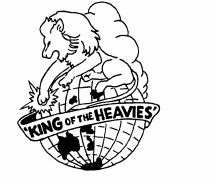
The 380th went overseas in April 1943 to become the second B-24 unit in the Fifth Air Force at that time after the 90th Bomb Group. The other Heavy Bomber unit (the 43rd) flew B-17s.[2] The group arrived at Fenton Airfield, Australia, and also encompassed a part of Western Australia at Corunna Downs Airfield, a top secret airfield in the Pilbara, north of Perth Western Australia in the RAAF's North West Area of operation, where it was assigned to 5th Air Force, V Bomber Command. The Command's purpose was to engage in destroying Japanese strongholds in the Pacific. Later moving to RAAF Base Darwin, the Group was placed under Royal Australian Air Force (RAAF) command, assigned to the Australian North West Area Command operating out of Darwin, Northern Territory, Australia, and was the only B-24 Liberator unit attached to the RAAF. The 380th was assigned to train RAAF personnel on the B-24 and to secure Australia's safety against a threatened Japanese invasion along its northern coast. Upon its arrival in Australia, the 380th BG immediately began combat operations. This was thus the only heavy bomber unit available to cover the whole of the Dutch East Indies (1,000,000 square miles) from July 1943 until late in 1944 At that time the successes in the New Guinea campaign had brought the other Fifth Air Force units close enough to the East Indies to join the 380th in that task. .[3]

During April and May 1944, the 380th engaged in the most intensive and sustained operations since arrival in the southwest Pacific, neutralizing the rear bases through which the Japanese might reinforce their air force in the Wakde-Hollandia area of the Dutch East Indies. From the end of May 1944 until it moved to Murtha Field, San Jose, Mindoro, Philippines in February 1945, the 380th concentrated on neutralizing enemy bases, installations and industrial compounds in the southern and central East Indies. In April 1945, Far East Air Force relieved the 380th of its ground support commitments in the Philippines. During the month, the Group flew the first heavy bomber strikes against targets in China and French Indochina. In June 1945, the 380th was placed under the operational control of the 13th Air Force for pre-invasion attacks against Labuan and on the oil refineries at Balikpapan in Borneo. For nearly two weeks, the Group's Liberators kept these targets under a state of aerial siege. After the Borneo raids, the 380th flew its last combat missions to Taiwan.
After the cessation of hostilities, the 380th moved to Okinawa and flew reconnaissance patrols over the Japanese islands. The group ferried released prisoners of war to Manila. On 18 October 1945, the unit was transferred to the 7th Air Force in the Philippines, where it moved to Clark Field on Luzon, and participated in the Sunset Project, the return of B-24s and their crews to the United States. Although some aircraft and crews were flown back to the United States, most of the aircraft from inactivating units were simply scrapped at Clark and personnel were returned via Navy ships from Manila.
In its service with the Australians, the 380th served longer under the operational control of an Allied country than any other Air Force unit (from June 1943 until February 1945).[4]
The 380th Bomb Group was inactivated at Clark Field on 20 February 1946.
B-24 Aircraft
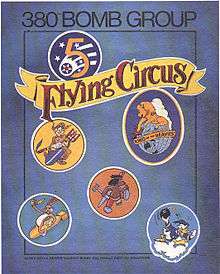
The basic unit of the United States Army Air Forces during World War II was the Group. Groups were built around the operational use of a specific type of airplane. In the case of the 380th, this was the B-24 Liberator Bomber. These planes were used in a particular class of mission suited to their capabilities. This was heavy bombardment associated with a large fraction of reconnaissance missions, particularly in the Australian phase of the 380th's service in the 5th Air Force. The 380th was assigned to the South West Pacific War Area because of the long-range capabilities of the Liberator and the need for its services there at that point in the war (Spring 1943). A total of 137 planes served in Australia and New Guinea. Of these, 53 served further in The Philippines.[5][6][7][8]
Bombing Missions
The 380th made the longest bombing missions of WWII, to the oil refineries at Balikpapan, Borneo (200 miles further than the Ploesti mission in Europe) and to those at Surabaja, Java (as long as Ploesti). Both of these missions were accomplished several times during their stay in Australia.[2]
In addition to attacks on the Japanese oil supply, the 380th was heavily engaged in crippling their shipping fleet to reduce the Japanese capability of supplying their far-flung forces. Numerous Japanese airfields were also heavily bombed in the East Indies to reduce the Japanese threat to Australia and New Guinea forces.[3]
As part of its duties in Australia, the 380th carried out the operational training of 52 Australian crews and their associated ground staffs so that the Australians could take over the East Indian campaign activities of the 380th when they were assigned to The Philippines in February 1945.[9]
Squadrons of the 380th

The 380th was composed of four Squadrons: the 528th, 529th, 530th, and 531st.
Mascots of the squadrons were:
- 528th Squadron—HERKY, the clown
- 529th Squadron—LITTLE BEAVER, the Indian boy sidekick of RED RYDER in the cowboy movies of the 1930s
- 530th Squadron—BUGS BUNNY
- 531st Squadron—a fierce DONALD DUCK
The insignia were sewn on their leather flying jackets as in all Air Force units in WWII.[4]
Location

As noted above, the 380th was based in Northern Territory, Australia, from May 1943 through February 1945. At that time, the Group moved to Murtha Strip, San Jose, Mindoro Island, The Philippines. There they joined the rest of the 5th Air Force in attacks on Formosa, Indo China, Japanese areas of The Philippines, and on China itself.[4]
As the war progressed, the 380th moved with the rest of the 5th Air Force to Yonton Strip, Okinawa, to begin the attack on Japan proper. As the world knows, the atom bomb negated this need and the war ended.
Cold War
The 380th Bombardment Group remained inactive from 20 February 1946 until its redesignation from Heavy to Very Heavy on 13 May 1947. On 29 May 1947, the Group was activated at MacDill Field, near Tampa, Florida, as a B-29 Superfortress reserve unit under the 49th Air Division. The group remained an inactive reserve unit until being called to active duty on 1 May 1951 during the Korean War. Fifteen days later on 16 May 1951, after the personnel had been processed for active duty and transferred to other units for service in Korea, the Group was inactivated.
Global War on Terrorism
Reactivated and redesignated as the 380th Expeditionary Operations Group in early 2002 to support the War in Afghanistan. The group participates in Operation Enduring Freedom (OEF) and Operation Iraqi Freedom (OIF).
See also
References
![]() This article incorporates public domain material from the Air Force Historical Research Agency website http://www.afhra.af.mil/.
This article incorporates public domain material from the Air Force Historical Research Agency website http://www.afhra.af.mil/.
Citations
- ↑ http://www.afcent.af.mil/News/ArticleDisplay/tabid/4779/Article/908380/airpower-from-the-ground-up.aspx
- 1 2 The Flying Circus - 380th Bomb Group, by James E. Fain, Jr., Howard L. Bergman, Grant C. Cannon and Julian A. Riser, Intelligence Officers of the 380th Bomb Group, Commanday-Roth Co., New York, NY, 1946, 190 pp. Reprinted 1988.
- 1 2 The Best in the Southwest - The 380th Bomb Group in World War II, by Glenn R. Horton, Jr., Library of Congress Card Number 95-079703, ISBN 0-9645959-0-7. Mosie Publications, Savage, MN, 1995, 513 pp.
- 1 2 3 Williams, Theodore J., and Gotham, Barbara J., WE WENT TO WAR: A WWII Wartime Roster of the 380th Bombardment Group (H), PART I: A WWII Wartime Roster of the 380th Bomb Group (H), published by Theodore J. Williams, West Lafayette, Indiana, September 1999.
- ↑ Williams, Theodore J., and Gotham, Barbara J., WE WENT TO WAR: A WWII Wartime Roster of the 380th Bombardment Group (H), PART V: The Planes We Flew: Australia/New Guinea Campaign, published by Theodore J. Williams, West Lafayette, Indiana, February 2002.
- ↑ Williams, Theodore J., and Gotham, Barbara J., WE WENT TO WAR: A WWII Wartime Roster of the 380th Bombardment Group (H), PART VI: The Planes We Flew: Philippines Campaign, published by Theodore J. Williams, West Lafayette, Indiana, September 2003.
- ↑ "380th Bomb Group - Alphabetical Listing of Aircraft". 380th.org. Retrieved 2013-02-07.
- ↑ "380th BG History - Part V: Aircraft Types". 380th.org. 2012-08-24. Retrieved 2013-02-07.
- ↑ Williams, Theodore J., and Gotham, Barbara J., WE WENT TO WAR: A WWII Wartime Roster of the 380th Bombardment Group (H), PART III: OUR BROTHERS-AT-ARMS. Members of the RAAF Liberator Squadrons of Australia Who Served Directly With the 380th Bomb Group, published by Theodore J. Williams, West Lafayette, Indiana, September 1999.
Bibliograpy
- Fain, James E.(ed.). The History of the 380th Bomb Group (H), AAF, Affectionately Known as the Flying Circus, November 1942 – September 1945. New York: Commandy-Roth Co., 1946.
- Horton, Glenn R., Jr. The Best in the Southwest: The 380th Bomb Group in World War II. Savage, Minnesota: Mosie Publications, 1995.
- King of the Heavies - 380th Bomb Group, 1942-1945, by Glenn R. Horton, Jr., and Gary L. Horton. Library of Congress Card Number 83-90348. Privately published, 1983, 184 pp.
- Maurer, Maurer (1983). Air Force Combat Units Of World War II. Maxwell AFB, Alabama: Office of Air Force History. ISBN 0-89201-092-4.
- Williams, Theodore J., and Gotham, Barbara J., WE WENT TO WAR: A WWII Wartime Roster of the 380th Bombardment Group (H), PART II: A Roster of the Flight Crews of the 380th Bomb Group (H), published by Theodore J. Williams, West Lafayette, Indiana, September 1999.
- Williams, Theodore J., Gotham, Barbara J., and Goble, Sue, WE WENT TO WAR: A WWII Wartime Roster of the 380th Bombardment Group (H), PART IV: A Listing of MOS/SSNs (Military Occupational Specialties/Service Speciality Numbers) Which Personnel of an Isolated Heavy Bombardment Group Would Probably Need During WWII, published by Theodore J. Williams, West Lafayette, Indiana, September 1999.
- Williams, Theodore J., and Gotham, Barbara J., WE WENT TO WAR: A WWII Wartime Roster of the 380th Bombardment Group (H), PART VII: Keep 'Em Flying, published by Theodore J. Williams, West Lafayette, Indiana, September 2004.
- Williams, Theodore J., and Gotham, Barbara J., WE WENT TO WAR: A WWII Wartime Roster of the 380th Bombardment Group (H), PART X: Why We Were in the Southwest Pacific Area: A Review, published by Theodore J. Williams, West Lafayette, Indiana, October 2006.
- Williams, Theodore J., and Gotham, Barbara J., WE WENT TO WAR: A WWII Wartime Roster of the 380th Bombardment Group (H), PART XI: Our Opposition ~ Japanese Anti-Aircraft Artillery and Fighter Units in the Southwest Pacific, published by Theodore J. Williams, West Lafayette, Indiana, March 2007.
- 380th.org
- 380th Expeditionary Operations Group Factsheet
External links
| Wikimedia Commons has media related to 380th Expeditionary Operations Group. |
- The 380th Bomb Group Association
- The 380th Bomb Group from the 5th Air Force History
- 380 History
- Snowflakes in the Desert, Airman Magazine, March 2004
- Deployed wing counts down to ‘The Move’
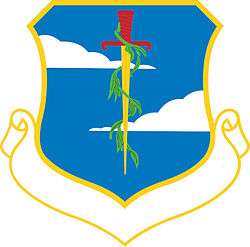

.svg.png)
.svg.png)